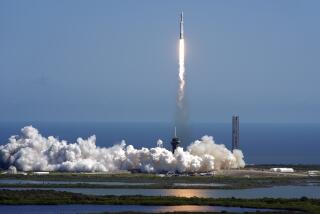SpaceX cargo mission blasts off to space station
A SpaceX Falcon 9 rocket launched from Cape Canaveral Air Force Station on Friday and sped through a cloud-covered sky on its way to deliver supplies to the International Space Station for NASA.
The Hawthorne-based rocket manufacturer launched the cargo mission despite a computer glitch aboard the space station and bad weather that threatened to push the liftoff back a day.
Promptly at 12:25 p.m. PDT, the rocket fired up its nine engines and launched into orbit, carrying a capsule packed with 5,000 pounds of supplies for the two American, one Japanese and three Russian astronauts aboard the space station.
The capsule, named Dragon, is scheduled to rendezvous with the space station on Sunday.
In a post-launch news conference, SpaceX founder and Chief Executive Elon Musk said the flight was “perfect as far as we could tell.”
“This is a happy day,” he said. “I’m just glad we were able to do the job we were contracted for, at least thus far.”
The blastoff from Space Launch Complex 40 occurred despite the failure of one of the space station’s backup computers, which assists a space capsule as it docks with the station.
The launch also marked the first time that SpaceX attempted to recover the first stage of its rocket after separation. During the news conference, Musk said the effort to retrieve the part so far appeared unsuccessful and he “wouldn’t give high odds that the rocket was able to splash down successfully” because of 25-foot waves and rough sea conditions.
More than 55,000 viewers tuned in to an online live stream hosted on SpaceX’s website. As plumes of smoke began rising from the rocket seconds before liftoff, the chat room exploded with activity as viewers virtually cheered on the launch.
NASA kept its Twitter followers updated with images from the rocket’s first minutes in flight, including the view from a SpaceX rocket camera with Earth in the background and a view of the Dragon spacecraft in orbit as it separated from the Falcon 9.
Afterward, William H. Gerstenmaier, NASA associate administrator for human exploration and operations, congratulated the SpaceX team on its “tremendous launch.”
NASA officials decided to go ahead with the mission despite the issue with a 50-pound box on the space station that runs computer commands to help move the station’s robotic arm along a truss.
The problem was found during a routine check of the device. Two astronauts are scheduled to conduct a spacewalk Wednesday to replace it with a spare.
NASA said the space station possesses enough redundant components to allow the SpaceX mission to launch.
The issue posed another hurdle for SpaceX, short for Space Exploration Technologies Corp., and its mission for NASA. The company initially had planned to launch its rocket in March, but several delays pushed back the mission.
This is SpaceX’s third flight in its $1.6-billion, 12-mission contract with NASA to transport cargo to the space station.
The capsule has an array of cargo onboard, including food, science experiments and even a set of legs for Robonaut 2, NASA’s humanoid robot aboard the space station, designed to help astronauts with tasks in space.
Although it appears that SpaceX will not recover the first stage of its rocket, Musk said the company is moving closer toward the first-ever fully reusable rocket — the Holy Grail in rocketry.
The Falcon 9 blasted off into orbit, then fell back to Earth before relighting its rocket engines to cushion its attempted landing.
SpaceX had practiced this before with the company’s 10-story Grasshopper test vehicle, but officials still put the chance of success at around 40%.
“We’re really starting to connect the dots of what’s needed,” Musk said. “I think we’ve got a decent chance of bringing a stage back this year, which would be wonderful.”
A reusable system could mean big savings in developing and operating the rocket. The closest example of a reusable launch system is the retired fleet of space shuttles, which were only partially reused after a tedious months-long overhaul.
On Monday, SpaceX signed a 20-year lease to take over NASA’s most historic launchpad, where the mighty Saturn V rocket made its moonshot and where the first space shuttle rumbled to life.
The space agency confirmed the deal for SpaceX to operate Launch Complex 39A at the Kennedy Space Center in Florida. The company plans to launch its upcoming Falcon Heavy rocket from there on its maiden flight early next year.
Musk also said SpaceX was on track to complete 10, or close to 10, rocket launches for government and commercial customers this year.
Twitter: @wjhenn
Twitter: @byandreachang
More to Read
Inside the business of entertainment
The Wide Shot brings you news, analysis and insights on everything from streaming wars to production — and what it all means for the future.
You may occasionally receive promotional content from the Los Angeles Times.











